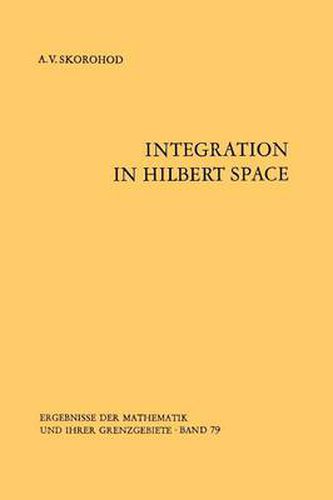Readings Newsletter
Become a Readings Member to make your shopping experience even easier.
Sign in or sign up for free!
You’re not far away from qualifying for FREE standard shipping within Australia
You’ve qualified for FREE standard shipping within Australia
The cart is loading…






This title is printed to order. This book may have been self-published. If so, we cannot guarantee the quality of the content. In the main most books will have gone through the editing process however some may not. We therefore suggest that you be aware of this before ordering this book. If in doubt check either the author or publisher’s details as we are unable to accept any returns unless they are faulty. Please contact us if you have any questions.
Integration in function spaces arose in probability theory when a gen eral theory of random processes was constructed. Here credit is cer tainly due to N. Wiener, who constructed a measure in function space, integrals-with respect to which express the mean value of functionals of Brownian motion trajectories. Brownian trajectories had previously been considered as merely physical (rather than mathematical) phe nomena. A. N. Kolmogorov generalized Wiener’s construction to allow one to establish the existence of a measure corresponding to an arbitrary random process. These investigations were the beginning of the development of the theory of stochastic processes. A considerable part of this theory involves the solution of problems in the theory of measures on function spaces in the specific language of stochastic pro cesses. For example, finding the properties of sample functions is connected with the problem of the existence of a measure on some space; certain problems in statistics reduce to the calculation of the density of one measure w. r. t. another one, and the study of transformations of random processes leads to the study of transformations of function spaces with measure. One must note that the language of probability theory tends to obscure the results obtained in these areas for mathematicians working in other fields. Another dir,ection leading to the study of integrals in function space is the theory and application of differential equations. A. N.
$9.00 standard shipping within Australia
FREE standard shipping within Australia for orders over $100.00
Express & International shipping calculated at checkout
This title is printed to order. This book may have been self-published. If so, we cannot guarantee the quality of the content. In the main most books will have gone through the editing process however some may not. We therefore suggest that you be aware of this before ordering this book. If in doubt check either the author or publisher’s details as we are unable to accept any returns unless they are faulty. Please contact us if you have any questions.
Integration in function spaces arose in probability theory when a gen eral theory of random processes was constructed. Here credit is cer tainly due to N. Wiener, who constructed a measure in function space, integrals-with respect to which express the mean value of functionals of Brownian motion trajectories. Brownian trajectories had previously been considered as merely physical (rather than mathematical) phe nomena. A. N. Kolmogorov generalized Wiener’s construction to allow one to establish the existence of a measure corresponding to an arbitrary random process. These investigations were the beginning of the development of the theory of stochastic processes. A considerable part of this theory involves the solution of problems in the theory of measures on function spaces in the specific language of stochastic pro cesses. For example, finding the properties of sample functions is connected with the problem of the existence of a measure on some space; certain problems in statistics reduce to the calculation of the density of one measure w. r. t. another one, and the study of transformations of random processes leads to the study of transformations of function spaces with measure. One must note that the language of probability theory tends to obscure the results obtained in these areas for mathematicians working in other fields. Another dir,ection leading to the study of integrals in function space is the theory and application of differential equations. A. N.